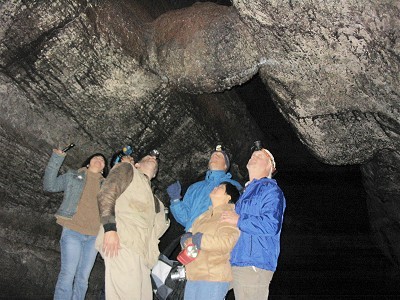Geology of Lavatubes
Lavatubes of the Mount St. Helens Region
Geological SettingLavatubesApe CaveCave Basalt MapCave ClimateVideo Clips
Ape Cave
 Ape Cave is located in the Gifford Pinchot National Forest. This tube was originally named for a group of local Boy Scouts (the St. Helens Apes in reference to ape-like large creatures reported to have attacked miners in the 1920s). It was once thought to be the longest lavatube in North America (12,810 feet) and its air temperature hovers around 42°F (Halliday and Larson, 1983). The entrance to the tube is a collapsed tumulus and conspicuously layered lava is visible in the walls.
Ape Cave is located in the Gifford Pinchot National Forest. This tube was originally named for a group of local Boy Scouts (the St. Helens Apes in reference to ape-like large creatures reported to have attacked miners in the 1920s). It was once thought to be the longest lavatube in North America (12,810 feet) and its air temperature hovers around 42°F (Halliday and Larson, 1983). The entrance to the tube is a collapsed tumulus and conspicuously layered lava is visible in the walls.
As with many lavatubes, Ape Cave is within a pahoehoe type flow, that is a ropy "taffy-like" consistency with conspicuous flow wrinkles. Pahoehoe formation is favoried by conditions of low viscosity and low shear strain. Numerous melt features (lava "stalactites" and "stalacmites" superficially resemble their precipitated carbonate namesakes but they are the result of molten lava dripping from lavatube ceilings. Gutters where series of subsequent flows occur show the levels of different eruptive episodes during the tube's history. At least two or more surges of lava seem to have flowed through a prior existing tube remelting its roof and forming the peculiar vertically elongate cross section that the tube presents.
At some point after the tube system was formed, a lahar flowed into the cave carrying a great deal of sandy material into the tube. White pumice granules that match the well known W tephra imply that the date of this event was around A.D. 1480-82 (Pringle, 1993; Foxworthy and Hill, 1982).
A trip to traverse Ape Cave naturally divides into two parts. First, the section downslope (south) from the main entrance is 1,330 m (3,910 feet) long and requires about 1 hour for a round trip. This segment is easy to travel across, but there is no lower exit and the return is made back through the same route. The upslope (north) tube segment counting from the main entrance is geologically of great interest but short crawls are required to navigate over breakdown collapse from the ceiling. A second exit is present at the end of the upper segment allowing a through-trip. The upper segment is 2,470 m (7,420 feet) long and requires a roundtrip of 4 to 5 hours.


